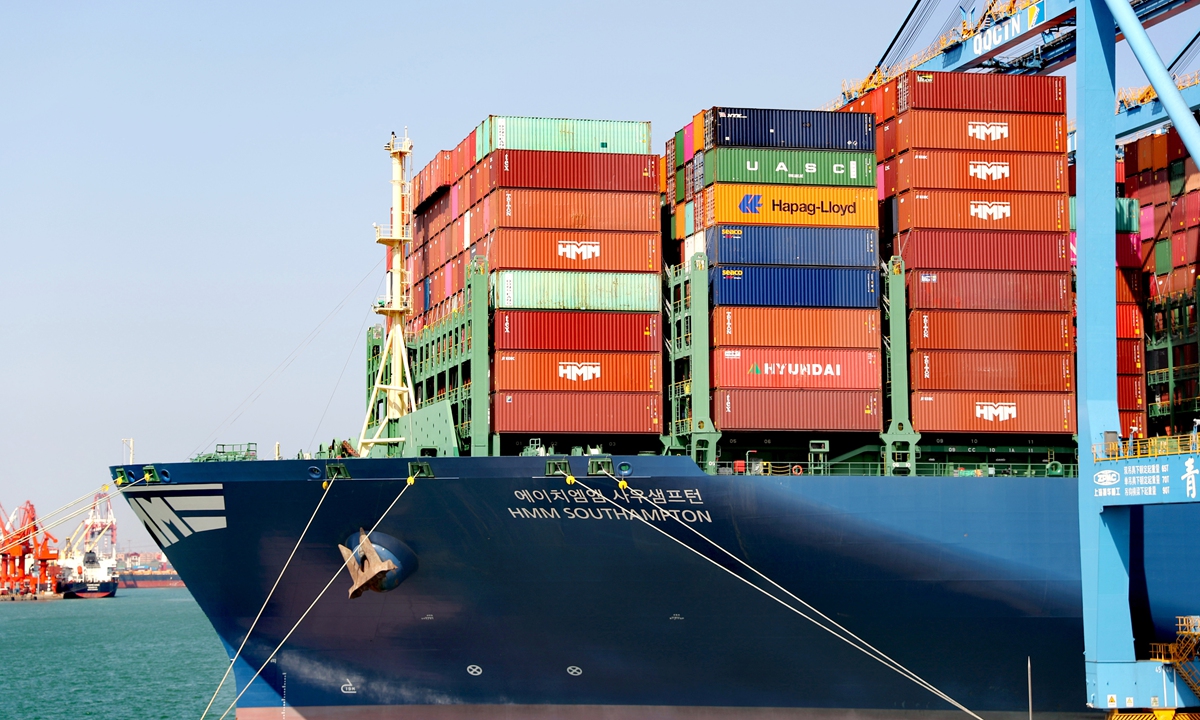COMMENTS / EXPERT ASSESSMENT
Biz Quick Take: China's surging foreign trade tells of the economy's global preeminence

A ship loading foreign trade goods at Qingdao Port Fully Automated Container Terminal in East China’s Shandong Province on Wednesday. By the end of September, more than 310 shipping lines have been opened at Shangdong Port thanks to the thriving operations driven by robust foreign trade. Photo: cnsphoto
China's foreign trade volume reached $6.05 trillion in 2021, surpassing the $6 trillion milestone for the first time, according to new data from the General Administration of Customs (GAC) on Friday. The sheer size of that commerce, the largest for a single country, is indicative of the world's economic tectonic shift across the Pacific Ocean, from the east rim to the west.
The spokesperson of GAC, Li Kuiwen, said the resilience of the Chinese economy and the recovery of the global economy helped the nation to maintain strong growth momentum. What he did not say explicitly is that China, shepherded by a team of highly competent policymakers, has also led the country's economy to gain more preeminence in the world.
Again, the "dual circulation" development roadmap, proposed by the top leadership, has proved to be fruitful. China's giant economy is not only being bolstered by domestic investment and consumption and 500 million increasingly affluent middle-class consumers, it is also supported by ever-rising outbound trade. And, an increasingly complicated manufacturing industry in China has set the solid foundation for the steadily rising foreign trade.
The US government's punitive trade tariffs and hostile economic and technological sanctions have failed to shut China's doors. Its ill-willed "decoupling" from China tactic is broken. China's market is now opening broader to foreign investors and multinational companies - verified by the bulging numbers of trade and FDI (foreign direct investment) which both set new records in 2021.
The ASEAN remains the largest trading partner of China, followed by the EU, the US, Japan and South Korea. By keeping dynamic trade and investment exchanges with China, the 10 ASEAN countries have been the rising economic stars of the past decade. Together they've elevated trade and investment on the basis of mutuality, equality and the win-win principle, creating more jobs and bringing prosperity.
Unlike the US government which is innately predisposed to assisting its close allies only while exploiting others, China has always sought inclusive growth and common prosperity with all its trade partners, in particular, the underdeveloped nations. And this is complemented with China's no-strings-attached cooperation on trade and investment decisions.
The US, since 2016 when Donald Trump was elected to the White House, has become too arrogant in global affairs and unilateral and protectionist in trade. The tariffs war with China, which Joe Biden inherited from Trump, hasn't benefited the US, as it's led to growing prices in daily necessities, food, furniture and durables in the US. In December, inflation in the US surged to 7 percent, the highest level since 1982. The price rises there are poised to trend even higher in 2022.
China has been a steady force in maintaining multilateralism and economic globalization, despite headwinds from Washington. Under the efforts of China, the world's largest free trade zone of the RCEP, encompassing 15 Asian and Pacific members, came into being on January 1. Covering 2.3 billion people and a third of the global GDP, the RCEP is set to boost trade and investment in the region while helping to create an integrated market and industrial supply chain. With booming trade, rising wealth will be created for the RCEP's 15 member economies.
As trade is an important driver of a country's economic growth, it is hoped that the signatories of the CPTPP could expedite expanding members by taking in heavyweight applicants such as China, the UK, and South Korea at the earliest.
Besides, the EU ought to reconsider its freezing of the landmark Comprehensive Agreement of Investment (CAI) with China. It is unwise to neglect the prospects of economic growth opportunities the CAI will bring to European countries as they watch Asia build up an edge. Following the US playbook, playing politics, and thumbing nose at China won't end well.
